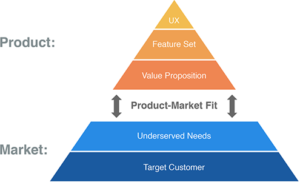What is Product-Market Fit?
Product-market fit describes a scenario in which a company’s target customers are buying, using, and telling others about the company’s product in numbers large enough to sustain that product’s growth and profitability.
According to entrepreneur and investor Marc Andreesen, who is often credited with developing the concept, product-market fit means finding a good market with a product capable of satisfying that market.

Why is it Important?
Alex Schultz, Facebook’s VP of Growth, says the biggest problem he sees facing the companies he advises is that they don’t have product-market fit when they think they do.
So, why is achieving it so important? Why do many venture capitalists demand evidence of product-market fit before investing in a company? Why does Andreesen, in fact, believe in the division of every startup’s life into two key stages: before product-market fit (BPMF) and after product-market fit (APMF)?
The answer is simple: Before you develop a product that you confirm enough people are willing to pay for, your team cannot afford to focus on other important strategic objectives such as growth or upselling existing users. Those initiatives could even be counterproductive, in fact, if you haven’t first determined that your product has enough of a market to sustain itself and generate a profit.
Who is Responsible for Product-Market Fit?
We generally associate the concept with marketing and product management. In reality, achieving it is a shared responsibility across the company. Sales, business development, support, finance, and all other departments help the company reach this important milestone.
How is Product-Market Fit Measured?
No single set of metrics can tell any business when it achieves product-market fit. But Andrew Chen, a venture capitalist, offers some signals that a company is heading in the right direction with its offering:
- When surveying potential customers or allowing them to test your product, does some segment indicate they will switch to your product?
- Are some users who have rejected similar products on the market willing to try yours?
- When user testing, do people group your product accurately with the right competitive offerings?
- Do users demonstrate an understanding of your product’s differentiators or unique value proposition?
- How do your underlying metrics (such as retention rates of users) measure up against those of your competitors?
Chen’s signals represent a mix of both qualitative and quantitative metrics. This is by design. Whatever methods your team uses to gauge success, you will want to include a mix of both as well. For example:
Quantitative:
- NPS score
- Churn rate
- Growth rate
- Market share
Qualitative:
- Word of mouth. (As Andreesen says, if your customers talk about your products with others, they effectively become your product’s sales reps.)
- Calls from the media or industry analysts come in much more frequently, and coverage of your product and company increases.

How Do You Achieve It For Your Product?
Just as the best way to measure product-market fit will differ for each company, there is no single path to achieving it. In his book, The Lean Product Playbook, Dan Olsen offers one high-level method that can help get your team started:
1. Determine your target customer
2. Identify underserved needs of that customer
3. Define your value proposition
4. Specify your minimum viable product (MVP) feature set
5. Develop your MVP
6. Test your MVP with customers
Then, based on those user tests and surveys, use metrics like the ones suggested above, from Andrew Chen, to determine if you’re headed in the right direction.
